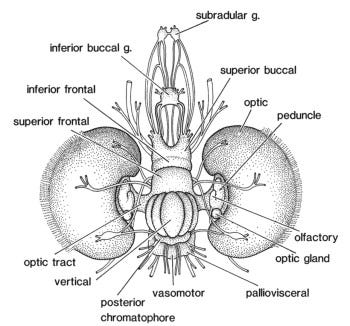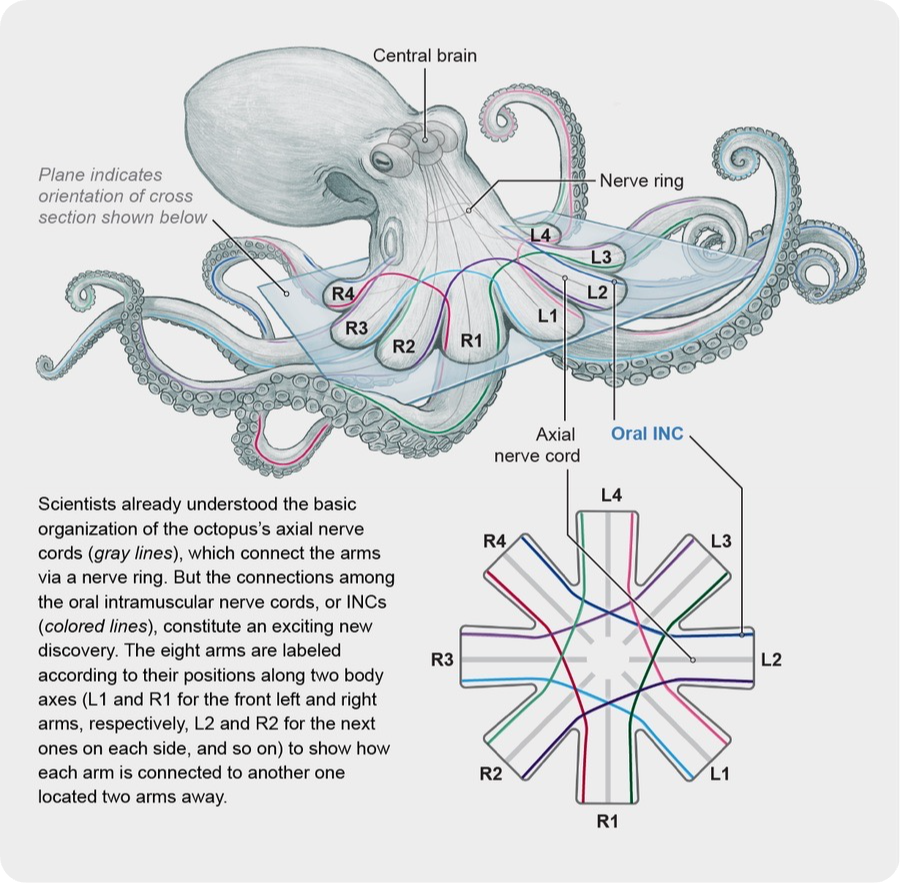The closest thing to alien intelligence on Earth
#79: Plus, evidence that people really do look like their dogs.
- The title of a new meta-analysis focused on whether humans look like their dogs. Across the studies, strangers really could identify dog-owner pairs from random pairs 62 - 80% of the time. Multiple studies found that long-haired women tend to prefer long-eared dogs, while short-haired women tend to prefer shorter eared dogs. However, that wasn’t what enabled people to correctly guess dog-owner pairs.
In the study with the largest sample size (502 undergrads), participants were still able to select the dog-owner pairs with 74% accuracy when only the eyes of each owner and dog were shown. It seems that people really do choose dogs that look similar to them, especially in the eyes. I made a detailed video here.
Cephalopod nervous systems evolved separately from other intelligent animals
In my opinion, cephalopods are the closest thing we have to alien intelligence. They can escape from enclosures1, plan for the future, solve puzzles, and pass the marshmallow test (denying a food reward now to get a better one in the future).
Our most recent shared ancestor was a simple flatworm that lived ~550 million years ago, before vertebrate life began. All other intelligent life, like mammals and birds (who have the most intelligence per cm³ of brain!2), split from the same evolutionary line more recently, after brains had already evolved. Cephalopod intelligence is a cool example of convergent evolution - where natural selection rewards similar traits in drastically different environments.
This split means that cephalopod brains developed from a different nervous system architecture (mollusks), and their resulting brains are wholly different from our own. They have an entirely different shape, and are much more decentralized throughout their bodies.

You may have heard that octopus arms “have a mind of their own”, and don’t require input from the brain.
It’s actually even weirder than this, because each arm is connected to two other arms, independent of the brain. Scientists still aren’t sure how their nervous system operates. What does this feel like experientially?

Why cephalopod intelligence confuses scientists
What makes cephalopod intelligence even weirder is that they break all the typical rules of thumb that evolutionary biologists have for explaining why intelligence evolves.
The most commonly cited explanation for the development of intelligence is the social intelligence hypothesis, though others do exist.
The great apes live in highly ordered troops, exhibiting both interpersonal relationships and structured hierarchies within the troop. They use these relationships to engage in altruistic, positive-sum behaviors like group foraging, communicating potential threats3, teaching children acquired skills, and aiding one another with grooming and wound treatment.
Cetaceans like dolphins and orcas live in pods, probably have complex language that they use to coordinate hunts and other behaviors, and teach their young complex hunting techniques that greatly increases their survival fitness.
Corvids function in the same way - they develop strong bonds, mate for life, help raise one another’s offspring, cooperate to access food, and play social games4.
Being social tends to be the rule for developing intelligence, since so many of the benefits of intelligence come from engaging in positive-sum cooperation with others. The creation of knowledge is the greatest benefit of intelligence, since it enables rapid progress as individuals make incremental improvements, and pass them onto the next generation. This process of continual knowledge creation happens much faster than is possible via evolution alone, and is the reason humans live the lives we do.
This is why cephalopods are such an outlier. They rarely cooperate, and almost none of them mate for life. In fact, most cephalopods only reproduce once in their lifetimes, and die almost immediately after doing so, leaving no opportunity to pass on acquired knowledge to their offspring. Typical lifespans are just ~2 years, so they don’t have a lot of time to develop their brains or compound their learnings.
This paradox has led to many papers explicitly seeking an answer, like “Grow Smart and Die Young: Why Did Cephalopods Evolve Intelligence?”. The TLDR is… we’re not sure.
One hypothesis hinges on the fact that they lost their protective shells at roughly the same time as they began developing brains and tentacles, and these factors hugely rewarded intelligence. Losing shells and gaining tentacles enabled them to fit in new spaces and prey on more species than before, but doing so required planning and intelligence, particularly since losing their external armor meant they could also be preyed upon by many more species. In video games, this type of build is called a “glass cannon”, since it is offensive but fragile. This double-sided pressure selected for the more intelligent cephalopods that could develop plans to catch prey while avoiding predators (octopus have been observed carrying around coconut shells as portable shelters!).
The problem with this explanation is that it could also be applied to the lifestyles of many species that are not notably intelligent. There is currently no satisfying explanation for why cephalopods are such intelligent outliers amongst invertebrates.
Cephalopods as model organisms
Given how unique cephalopods are, scientists have been searching for a species of octopus that would be well-equipped to be a model organism - a small, rapidly-reproducing species that can be thoroughly studied in labs to understand fundamental biological principles that can be extrapolated to other species. The most famous model organisms include E. coli, the fruit fly D. melanogaster, and the worm C. elegans - we have these three to thank for countless biological, genetic, and medical breakthroughs.
After years of searching, a small species of octopus called the pygmy zebra octopus (Octopus chierchiae) seems to be the perfect candidate. They’re about the size of a grape when fully grown, they reproduce quickly, and unlike most octopuses, they survive after laying eggs! The first cephalopod genome wasn’t sequenced until 2015, so continued study of this model organism will hopefully yield answers to some of the most perplexing aspects of cephalopods. What are the extent of their RNA-editing abilities? How far does their theory of mind extend, considering they can impersonate other creatures to scare off predators? How much of their communication is learned versus innate, including their ability to communicate via bioluminescence? There are so many more questions than answers when it comes to cephalopods. Greater focus on this model organism will likely yield insights that can be applied across taxa, and genetics.
Studying how cephalopod intelligence evolved, and how it functions today, will not only help us understand the commonalities between intelligent beings on Earth, but will also illuminate what we may have in common with truly alien intelligence.
Thanks for reading! Next week I’ll delve into some surprising new discoveries in my favorite cephalopod: the cuttlefish.
One New Zealand octopus even made it back to the sea!
Bird brains are more densely packed with neurons. Many of their brains approach great ape numbers of neurons due to this greater density, and corvids in particular are capable of the same intellectual feats as chimpanzees. Something to think about the next time a crow looks at you… More involved explanation here.
Chimpanzees can communicate specific threats. For example, chimpanzees have a distinct call for snake.






